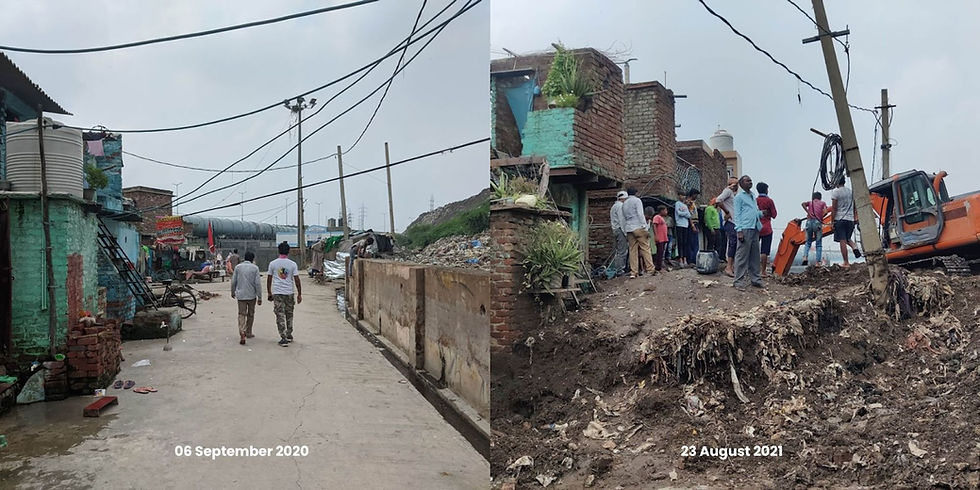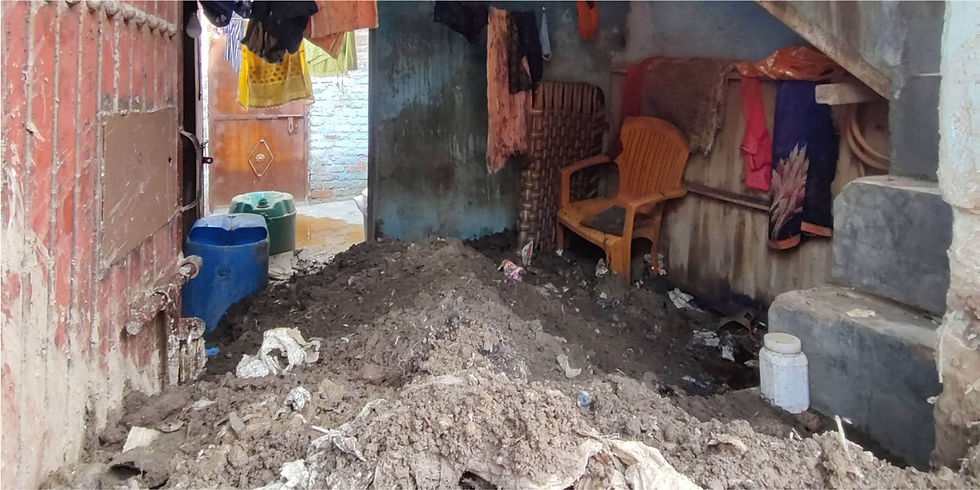Systemic Collapse: Living on the Edge in Bhalswa, Delhi
- Gunraagh Talwar
- Apr 28, 2022
- 4 min read

Picture 01: Mr. Ramnath Kamthi inspects collateral damages following the collapse
When the Kamtis migrated to Delhi in the 1980s, they could not have imagined losing their grandchildren to the city’s waste. Delhi's rapid urban development and ever-increasing population have led to a complex problem, making it difficult to determine which came first. However, it must be acknowledged that this progress has come at a cost. In the pursuit of creating a "global metropolis and a world-class city," several issues have arisen that are of great concern. In the case of Bhalswa, a census town located in the northern part of the city, a massive dumpsite has taken over the town's identity. However, in the authors' understanding, this was not always the case. Bhalswa was once home to a thriving wetland ecosystem centered around its horseshoe lake. Because it is located just beyond the city's formal development limits, Bhalswa's decline is a story of neglect and marginalization.

Picture 02: The Dumpsite collapsed over the community’s access street.
Ramnath Kamti went to Delhi to explore job opportunities after being invited by his relatives who had migrated as early as the 1970s. As a young and able-bodied individual, he found a job at a petrol pump in the busy south of the city, and he was able to find accommodation nearby. However, after a couple of years, the family had to move to Bhalswa as they were unable to cope with the rising rent. They settled in a modest dwelling amongst their kin in Basant Dada Patil Nagar, where they finally had a home to call their own. Although Mr. Kamti had to commute for long hours, the family was happy. This happiness was short-lived as the community had chosen to live adjacent to a low-lying area designated for operations as a sanitary landfill.

Picture 03: The unprecedented growth of the Bhalswa dumpsite
As the Kamti family continued to grow, so did the mound. Originally planned as a sanitary landfill, unchecked waste disposal and unmonitored growth quickly transformed the site into a dumping ground. This led to a range of concerns for the community. Initially, the stench caused hazardous air pollution, which the city can now fully understand. However, the worst effects were experienced a few years later when the dumpsite's leachate contaminated the groundwater. This had several repercussions, including a scarcity of reliable groundwater, forcing members of the community to seek out basic necessities from surrounding areas. Those who were unable to do so were forced to consume contaminated groundwater, resulting in chronic illness. While temporary solutions such as water tankers were initially helpful, the dumpsite collapsed over an access road in 2004, cutting off a significant portion of the community's access to tanker provisions. The water scarcity and inadequacy brought a range of sanitation hazards, forcing the community to rely on self-created infrastructure. While these challenges may be common to other informal settlements, proximity to the dumpsite has exacerbated the situation.
Today, Bhalswa is nothing like the area the Kamti’s decided to call their home. One instance, in August 2021, is reflective of the degree of the situation.

Picture 04: Debris from the dumpsite’s collapse forced itself through dwellings
After heavy rainfall during the season, the dumpsite weakened considerably, causing new formations to collapse over Basant Dada Patil Nagar one morning. While Mr. Kamti, now a grandfather, was commuting to work, his wife, Rita Devi, was competing with the community to obtain water for their household. This week, the settlement has not received its usual supply, causing tensions between the residents to reach a peak. When some people in line informed Rita that the dumpsite had collapsed over her house, she initially did not believe them, assuming it was just an excuse for others to jump ahead in the queue. However, when she finally accepted the truth, she could hardly believe her eyes.

Picture 05: The Dumpsite’s collapse following annual monsoonal rainfall (Ipsita Choudhury)
Rita was faced with a daunting sight as she approached her house - what was once a street had now become a part of the dumpsite. As she carefully navigated through the debris, she struggled to gather the courage to call her husband for help. A collapsed chunk had breached the brick wall that separated the dumpsite from the colony, obstructing the entrance and trapping their infant grandchild inside the house. The panicked family urgently needed help, and thankfully, a few members from the community were able to alert the necessary authorities.

Picture 06: The Kamti Family’s dwelling, a month before the collapse.
Without any immediate assistance, the community banded together to approach the affected houses via the terraces and evacuate those in need. However, when local politicians and civic workers arrived on site, the situation devolved into a political blame game. It was only when the arriving fire engine couldn't reach the site due to a lack of a clear path that they finally worked together to devise a solution. Unfortunately, the incident resulted in both structural and physical damage to the affected dwellings, as well as collateral damage and implicit loss of livelihood.

Picture 07: Rita Devi cleans her haudi, a small reservoir to collect groundwater
Rita exclaims, "I wonder how many lives would have been lost if this incident had occurred at night while we were all asleep." As a witness to the incident, the author interacted with the Kamti family and other affected individuals to amplify their voices and provide assistance through fundraising. In the following days, those affected worked tirelessly to clear debris from their homes and restore damages. Rohit Kamti, one of the affected individuals, recalls, "I could hardly sleep the next night, fearing that the dumpsite would collapse once again.”

Picture 08: Residents take on the civic work of clearing debris and making way

Picture 09: The Dumpsite’s Collapse and its impact on the community at Bihari Samaj Vishwanath Puri, a JJ Cluster abutting the landfill
Months have passed since the incident, and although those affected have resumed their everyday lives, not much has changed. The North MCD continues to sift through the dumpsite in its effort to address its volumetric concerns, but the retaining wall separating the dumpsite from the settlements has yet to be repaired. The collapse of the dumpsite highlights a failure in the systems that serve us, specifically the city's centralized waste management system.



Comments